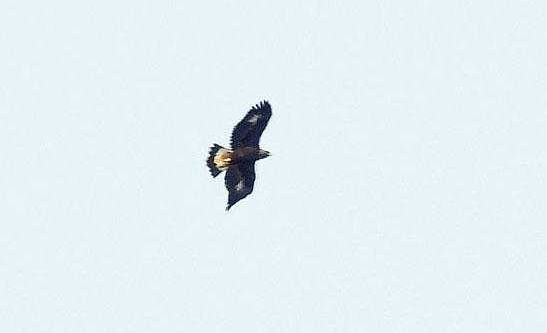Everywhere I've lived, new birds have enriched my life
- Bruce Glick: Gone Birding
- August 5, 2020
- 2539
Recently, I was asked to talk about birds as part of our summer story-telling at church. I’d like to share some of those thoughts with you today.
Bee hummingbirds are found only in Cuba. They are a mere 2 inches long and weigh about 2 grams, less than the weight of a dime. Their eggs are about the size of a coffee bean. Our ruby-throated hummingbirds are about twice that size.
People sometimes ask how I got interested in birds. When I was about 9 or 10 years old, my parents introduced me to a kingfisher at the Killbuck Marsh near Wooster. I can still see that beautiful, sleek, blue bird, perched on a wire over a ditch, then seeing it dive down into the water to catch a minnow. From that moment on, I was excited by each new bird I saw: at our bird feeders at home, in the nearby woods, and on family vacations to Florida, Colorado and much of the United States.
After college my wife Helen and I have been fortunate to live in different parts of the world while working with Goshen College and Mennonite Central Committee. And everywhere we lived, there were new birds to enrich my life.
In the Bible we read about not worrying, and one example given is that birds don’t store up food in barns and presumably don’t worry. This example seems to work in the story; however, birders know acorn woodpeckers and other birds store thousands of nuts for the winter. And they remember where most of them are hidden. Telephone poles in Southeastern Arizona are often dotted with hundreds of nut-hiding holes.
The children’s story at church featured two kids who taught their pet chickens that if they would fly up to a perch on a horizontal branch, the kids weren’t allowed to bother them. It worked. You might be surprised to know that in Asia, including in the Philippines where we lived for a year, there is a wild bird called a red junglefowl. It looks very much like a domestic rooster, but it is incredibly shy and hard to find in the dense rain forests.
Once while Helen and I were hiking in the Philippines, we heard a red junglefowl calling (well, crowing), but we couldn’t find it no matter how hard we tried.
While hiking on Mt. Apo near Davao City, we were fortunate to see a soaring Philippine eagle, one of the largest and rarest eagles in the world. Around the world many species of eagles are endangered, but wherever you go, eagles are spoken about with awe.
Raptors including hawks, eagles and owls are my favorite family of birds. In 2008 I spent two weeks in Cardell, Mexico with two birding friends and dozens of other birders from around the world. Every fall millions of hawks migrate over Cardell, where the mountains almost reach the ocean. Birders who come to observe this spectacle can expect to see over 100,000 broad-winged hawks or a similar number of Swainson’s hawks in a single day, plus a wide variety of other raptors, pelicans, vultures and other soaring birds. I have never experienced anything like it, before or since.
Our days may be stressful even in normal times, and now they may include loss of a job, working at home while taking care of children and more. We often can’t interact with parents and grandparents or with church and family friends. A great deal of patience and creativity is needed. We may need to find new ways to deal with the stress and to recharge.
Getting outside to walk the local trails and to visit parks and natural places is good for us. Children especially delight in the outdoors. Take them outside and soon they will explore every plant, bug, butterfly, firefly and bird they can find. They will find things you didn’t even know existed. And these days you can just point your phone, using the Seek app or iNaturalist for the identification. For birds there are many excellent apps such as Merlin, Sibley Birds or Audubon, any of which will help you identify birds and bird songs while also showing you where they occur and when they can be found.
I have long been fascinated by bird migration. Scott Weidensaul is an author and naturalist who has written widely about bird migration. His book, "Living on the Wind," documents the mind-boggling journeys many birds make every year. Think about the migrant birds that nest near us each summer: hummingbirds, house wrens, catbirds, orioles, rose-breasted grosbeaks, flycatchers, swallows and more. All of these birds leave our area to spend the northern winter far to our south, in the Southern U.S., Mexico, Central America, the Caribbean or South America, often traveling thousands of miles each way.
Many ruby-throated hummingbirds fly nonstop across the Gulf of Mexico. No wonder they feed so heavily in the fall, nearly doubling their weight before making such an epic journey. Even then, they are dependent on favorable wind conditions to survive the long, nonstop flight. Swainson’s hawks fly from the Western U.S. to Argentina every fall. Some shorebirds fly from their nesting sites in the tundra of Alaska, east to Northern Europe and then south to Africa. They may return to the arctic via a different route in the spring.
Imagine being a newborn sandpiper, born in the tundra of Alaska or Northern Canada. Your parents feed you until you begin to fly, and then they leave for a destination thousands of miles to the south. Sometime later, fueled up and ready to go, something tells you how to fly to the place where your parents went. Wow!
Stay safe and good birding.
Email Bruce Glick at bglick2@gmail.com.

